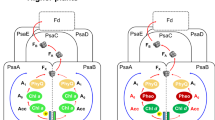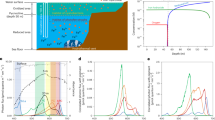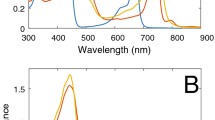Abstract
Cyanobacteria in the genus Acaryochloris are the only known oxyphototrophs that have exchanged chlorophyll a (Chl a) with Chl d as their primary photopigment, facilitating oxygenic photosynthesis with near infrared (NIR) light. Yet their ecology and natural habitats are largely unknown. We used hyperspectral and variable chlorophyll fluorescence imaging, scanning electron microscopy, photopigment analysis and DNA sequencing to show that Acaryochloris-like cyanobacteria thrive underneath crustose coralline algae in a widespread endolithic habitat on coral reefs. This finding suggests an important role of Chl d-containing cyanobacteria in a range of hitherto unexplored endolithic habitats, where NIR light-driven oxygenic photosynthesis may be significant.
Similar content being viewed by others
Log in or create a free account to read this content
Gain free access to this article, as well as selected content from this journal and more on nature.com
or
References
Chen M, Schliep M, Willows RD, Cai Z-L, Neilan BA, Scheer H . (2010). A red-shifted chlorophyll. Science 329: 1318–1319.
Enriquez S, Méndez ER, Iglesias-Prieto R . (2005). Multiple scattering on coral skeletons enhances light absorption by symbiotic algae. Limnol Oceanogr 50: 1025–1031.
Fleming ED, Prufert-Bebout L . (2010). Characterization of cyanobacterial communities form high-elevation lakes in the Bolivian Andes. J Geophys Res 115: G00D07.
Goh F, Allen MA, Leuko S, Kawaguchi T, Decho AW, Burns BP et al. (2009). Determining the specific microbial populations and their spatial distribution within the stromatolite ecosystem of Shark Bay. ISME J 3: 383–396.
Halldal P . (1968). Photosynthetic capacities and photosynthetic action spectra of endozoic algae of the massive coral Favia. Biol Bull 134: 411–424.
Kashiyama Y, Miyashita H, Ohkubo S, Ogawa NO, Chikaraishi Y, Takano Y et al. (2008). Evidence for global chlorophyll d. Science 321: 658.
Koehne B, Elli GG, Jennings R, Wilhelm C, Trissl H-W . (1999). Spectroscopic and molecular characterisation of a long wavelengths absorbing antenna of Ostreobium sp. Biochim Biophys Acta 1412: 94–107.
Kühl M, Chen M, Larkum AWD . (2007). Biology of the chlorophyll d-containing cyanobacterium Acaryochloris marina. In: Seckbach J (ed). Algae and Cyanobacteria in Extreme Environments. Springer: Berlin, pp 101–123.
Kühl M, Chen M, Ralph PJ, Schreiber U, Larkum AWD . (2005). A niche for cyanobacteria containing chlorophyll d. Nature 433: 820.
Kühl M, Polerecky L. (2008). Functional and structural imaging of phototrophic microbial commmunities and symbioses. Aq Microb Ecol 53: 99–118.
Magnusson SH, Fine M, Kühl M . (2007). Light microclimate of endolithic phototrophs in the scleractinian corals Montipora monasteriata and Porites cylindrica. Mar Ecol Progr Ser 332: 119–128.
Martínez-Garcia M, Koblízek M, López-Legentil S, Antón J . (2010). Epibiosis of oxygenic phototrophs containing chlorophylls a, b, c, and d on the colonial ascidian Cystodytes dellechajei. Microb Ecol, published ahead of print, doi:10 1007/s00248 1010-9694-6.
McNamara CJ, Perry VI TD, Bearce KA, Hernandez-Duque G, Mitchell R . (2006). Epilithic and endolithic bacterial communities in limestone from a Mayan archaeological site. Microb Ecol 51: 51–64.
Miller SM, Augustine S, Olson TL, Blankenship RE, Selker J, Wood AM . (2005). Discovery of a free-living chlorophyll d-producing cyanobacterium with a hybrid proteobacterial/cyanobacterial small-subunit rRNA gene. Proc Natl Acad Sci USA 102: 850–855.
Miyashita H, Ikemoto H, Kurano N, Adachi K, Chihara M, Miyachi S . (1996). Chlorophyll d as a major pigment. Nature 383: 402.
Mohr R, Voss B, Schliep M, Kurz T, Maldener I, Adams DG et al. (2010). A new chlorophyll d-containing cyanobacterium: evidence for niche adaptation in the genus Acaryochloris. ISME J 4: 1456–1469.
Murakami A, Miyashita H, Iseki M, Adachi K, Mimuro M . (2004). Chlorophyll d in an epiphytic cyanobacterium of red algae. Science 303: 1633.
Ohkubo S, Miyashita H, Murakami A, Takeyama H, Tsuchiya T, Mimuro M . (2006). Molecular detection of epiphytic Acaryochloris spp. on marine macroalgae. Appl Environ Microbiol 72: 7912–7915.
Ringeltaube P, Harvey A . (2000). Non-geniculate coralline algae (Corallinales, Rhodophyta) on Heron Reef, Great Barrier Reef (Australia). Bot Marina 43: 431–454.
de los Rios A, Grube M, Sancho LG, Ascaso C . (2007). Ultrastructural and genetic characteristics of endolithic cyanobacterial biofilms colonizing Antarctic granite rocks. FEMS Microbiol Ecol 59: 386–395.
Swingley WD, Chen M, Cheung PC, Conrad AL, Dejesa LC, Hao J et al. (2008). Niche adaptation and genome expansion in the chlorophyll d-producing cyanobacterium Acaryochloris marina. Proc Natl Acad Sci USA 105: 2005–2010.
Acknowledgements
The work was conducted under a Marine Parks Permit (G06/178151.1) from the Great Barrier Reef Authority and was supported by the Danish Natural Science Research Council and the Australian Research Council. We thank the Heron Island Research Station staff, Martin Schliep and Waleed Abu Al-Soud for technical assistance, HPLC and sequencing analysis.
Author information
Authors and Affiliations
Corresponding author
Additional information
Supplementary Information accompanies the paper on The ISME Journal website
Rights and permissions
About this article
Cite this article
Behrendt, L., Larkum, A., Norman, A. et al. Endolithic chlorophyll d-containing phototrophs. ISME J 5, 1072–1076 (2011). https://doi.org/10.1038/ismej.2010.195
Received:
Revised:
Accepted:
Published:
Issue date:
DOI: https://doi.org/10.1038/ismej.2010.195
Keywords
This article is cited by
-
Down to the bone: the role of overlooked endolithic microbiomes in reef coral health
The ISME Journal (2020)
-
Beneath the surface: community assembly and functions of the coral skeleton microbiome
Microbiome (2019)
-
A novel species of the marine cyanobacterium Acaryochloris with a unique pigment content and lifestyle
Scientific Reports (2018)
-
Exploring coral microbiome assemblages in the South China Sea
Scientific Reports (2018)
-
Characterization of a newly isolated freshwater Eustigmatophyte alga capable of utilizing far-red light as its sole light source
Photosynthesis Research (2018)



